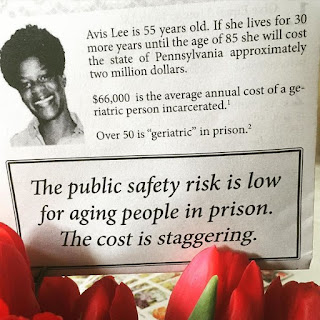 |
| "If the risk is low, let them go" |
Nearly 40 percent of U.S. prisoners are behind bars for no compelling public safety reason, according to a recent report by NYU's Brennan Center for Justice. Their groundbreaking analysis shows how to drastically cut our prison population while still keeping crime rates low.
Some day we will look back at our 18th century-based practice of warehousing people in steel cages as not only an unusually cruel form of punishment but as extraordinarily costly and unproductive.
We could do far better using restorative approaches that would require people to make restitution to their victims and/or enable them to get actual treatment for their addictions. Temporary confinement may still be necessary for offenders who are clearly a danger to their community, but long term incarceration should never be accepted as the norm.
Here are four ways to help reduce the human and financial costs of over-incarceration:
1. Regularly post the actual costs of our courts' decisions. Prison sentences carry a hefty price tag, not only involving the $28,000 or more per year for each inmate's room and board, but also the untold cost in wages and taxes lost for their communities and families, plus the cost of increased social services needed when breadwinners are removed from the community.
2. Make each local jurisdiction responsible for the cost of incarcerating their own offenders. Virginia's state-funded Department of Corrections represents a $1 billion a year industry, and as with every expense covered by the state, there is no free lunch. Professor W. David Ball of the Santa Clara University School of Law recommends that states defund prisons and make counties pay for inmates they incarcerate. Or the state could collect revenue as before and allocate the money now spent on prisons to counties (based on their violent crime rate), who would then need to determine their communities’ priorities.
3. Require each prosecutor, judge, magistrate and law enforcement officer to spend a day at a prison or jail once a year. This was proposed for judges by former Virginia Attorney General Mark Earley at a community meeting held here over a year ago, in order for them to "see where they are sending people". The purpose would not be to have officials become softer on crime, but to encourage them to consider more humane and effective alternatives to incarceration.
4. Urge the Parole Board to free aging, physically ill and other inmates who qualify for release. Due to excessively long sentences, the cost of caring for our aging prison population is increasing dramatically, while the likelihood of older persons committing crimes is greatly reduced. Too many inmates who for years have demonstrated exemplary behavior have been denied parole year after year in spite of their best efforts.
 |
| source |
Tomiko Shine, researcher with Maryland’s RAPP (Release Aging Persons In Prison) will lead a discussion on this at the Trinity Presbyterian Church at noon Thursday, February 9, along with Earl Nelson, recently released after spending 48 years in prison. This will be followed by a 1 pm showing of producer Wynona Hogan’s just released 55-minute documentary on our local Rockingham and Middle River jails.
No comments:
Post a Comment